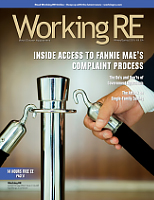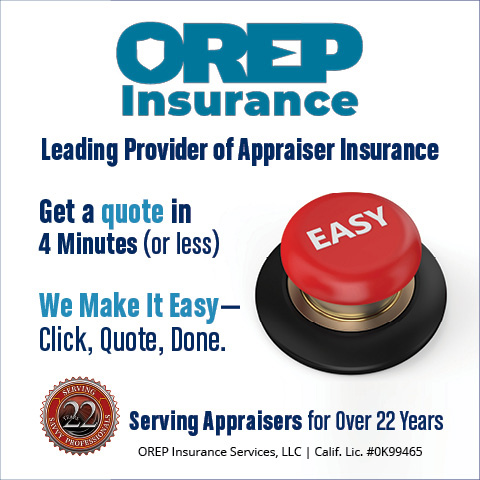 |
> The Appraiser Coach
> OREP E&O |
Decoding Fannie Mae: A Deep Dive into Key Appraisal Resources
by Bill Temple, Appraisal Compliance Strategist for Amrock, SRA, AI-RRS, ASA, MNAA, ACFE and Erica DelToro, Senior Business Strategist for Amrock
In the dynamic landscape of real estate appraisals, staying informed about industry guidelines is paramount. This article serves as a comprehensive guide, directing appraisers to key Fannie Mae resources and examining three key pillars of Fannie Mae’s material: the Fannie Mae Selling Guide, the Fannie Mae Appraiser Updates, and the public-facing Fannie Mae Collateral Underwriter® (CU®) website. This piece will also discuss the upcoming new Uniform Appraisal Dataset (UAD), expected in 2025.
Fannie Mae, Freddie Mac, and Federal Housing Administration (FHA) are in a constant state of change, and it is very important to keep the industry up to date. It is crucial for appraisers to stay informed of the most current guidelines and information to minimize risk. Appraisers who are not well informed may find themselves navigating challenges. Whether interacting with lenders, clients, state boards, or government agencies, the repercussions of outdated information can be significant.
Fannie Mae Selling Guide
Fannie Mae’s ownership of the current appraisal forms underscores its vital role in shaping the foundation of appraisal processes for any company or Appraisal Management Company (AMC) that hires appraisers to provide appraisal services for lending purposes. The Fannie Mae Selling Guide is like the owner’s manual for the forms. It advises how to address certain appraisal situations and guides solving an appraisal problem.
For example, a simple Google search using ‘Fannie Mae Selling Guide accessory units’ will pull information from the current Selling Guide on what is needed to appraise a property that may or may not have an accessory unit. As professionals in the field of real estate appraisals, appraisers’ time is precious, and the efficiency with which appraisers access information directly impacts the industry.
A few minutes spent on a focused search can serve as a preemptive strike against potential issues, saving considerable time and energy in the long run.
Fannie Mae Appraiser Updates
Fannie Mae has published an ‘Appraiser Update’ every quarter since 2017. The updates are generally a half dozen pages and contain articles about current appraisal topics and issues. One of the more interesting ones, for example, is the June 2023 issue. In it, there is an article about Fannie Mae using ‘image recognition technology in appraisal report reviews.’ This is used to identify inconsistencies in quality and condition ratings by comparing photos in the appraisal report with photos from other sources.
Why is this important? It’s a widely recognized fact that Fannie Mae possesses the authority to issue repurchase demands to lenders if they perceive the appraisal to be defective. One of the sticking points for a repurchase demand is the evaluation of the condition and quality ratings, which do not look appropriate or are inconsistent with the UAD definitions and explanations that are part of the appraisal report. Appraisers must be vigilant in keeping their software current and possess a deep comprehension of what condition and quality ratings should be employed in accordance with the latest guidelines.
(story continues below)
(story continues)
Fannie Mae Collateral Underwriter®
Many may not realize that there is a public-facing website for Fannie Mae’s CU® that includes links to information and training for anyone to utilize. Exploring the site and information can help an appraiser understand what happens to an appraisal when it is delivered to the Uniform Collateral Data Portal (UCDP).
Currently, the only appraisal forms that are delivered through the automated review are the 1004 URAR and the 1073 Condominium Appraisal forms. Other forms, such as the 1025 2-4 Family Small Income and the 2055 Exterior Only report form, are not scored in CU® as they are a UAD form. Fannie Mae’s website describes CU® as a web-based application that uses a database of over 50 million appraisals to help lenders manage collateral risk, underwriting, and quality control.
CU® offers comparable sales data, aerial mapping, market trends, and local market conditions. It can be used to identify data discrepancies, analyze comparable sale selection and adjustments.
Part of the training materials also explains that it requires a skilled reviewer or underwriter to use CU® in the manner it was designed for.
Note that per Fannie Mae, no one using CU®—including an underwriter or a reviewer—should ever send an appraiser a screenshot or a copy of a CU® message showing CU® model sales or warning messages. This would violate the lender’s licensing agreement with Fannie Mae. For more information regarding CU®, the Collateral Underwriter® website houses links to videos and very informative documents.
Uniform Appraisal Dataset Forms Redesign Initiative
By now, every appraiser is or should be aware that all current appraisal report forms are being replaced by a newly redesigned form for release in 2025. It is described as a single, flexible, and dynamic report for any residential property type. Appraisers can navigate to the GSE’s websites to see the latest information. For example, appraisers can read the Partner Playbook, which provides information on “the why” behind the new forms and timelines or check out the UAD and Forms Redesign FAQs. As this evolving phase nears completion, staying informed in preparation for its release is worthwhile.
Final Thoughts
Appraisers today have access to an abundance of information right at their fingertips that was not available years ago. A key to success in this field lies in the commitment to staying informed— whether it’s embracing the latest guidance from Fannie Mae, leveraging advanced tools and technology, or tapping into the insights shared by industry experts through informative videos and documents. As the industry continues to move forward, remember that staying current ensures that today’s appraisers remain at the forefront of excellence.
About the Author
Bill Temple is the Appraisal Compliance Strategist at Amrock. With over four decades of experience as an appraiser, he holds licenses in multiple states and a territory. Bill is actively involved in various professional appraisal organizations and is committed to staying informed about industry standards and practices. His role as a subject matter expert and interest in exploring changing guidelines, rules, methods, and practices highlight his dedication to keeping current with developments in the appraisal profession.
Erica Deltoro is a seasoned appraisal senior strategist at Amrock with 13 years of experience in real estate valuation. She holds a Project Management Certificate, further enhancing her skill set and contributing to her well-rounded professional profile. Known for her enthusiasm about industry advancements, Erica embraces each day as an opportunity to expand her knowledge and skill set.
OREP Insurance Services, LLC. Calif. License #0K99465



